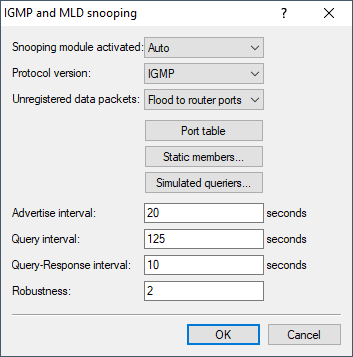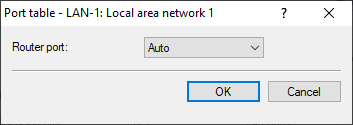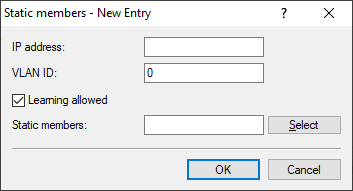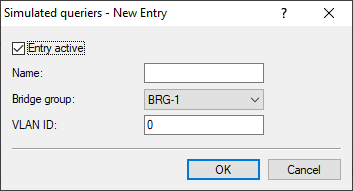In LANconfig, IGMP/MLD snooping are configured under


- Snooping module activated
- Activates or deactivates IGMP/MLD snooping in the device and all of the defined querier instances. Without IGMP/MLD snooping the bridge functions like a simple switch and forwards all multicasts to all ports.
Possible values:
- On
- Off
- Automatic
- Automatic
Important: If this function is deactivated, the bridge sends all IP multicast packets on all ports. With a change of the operating mode, the bridge completely resets the IGMP/MLD snooping function, i.e. it deletes all dynamically learned values (memberships, router-port properties). - Protocol version
- Specify the supported protocols: IGMP, MLD, or both.
- Unregistered data packets
- This setting defines the handling of multicast data packets with a destination address outside of the reserved ranges "224.0.0.x" (IPv4) and "FF02::1" (IPv6), for which neither static memberships were defined nor were dynamic memberships learned.
Possible values:
- Flood to router ports only: Sends these packets to all router ports.
- Flood to all ports: Sends these packets to all ports.
- Discard: Discards these packets.
- Router-Ports-only
- Port table
-
This table is used to define the port-related settings for IGMP/MLD snooping.

- Port
- The port for which the settings apply.
Possible values:
- Selects a port from the list of those available in the device.
- N/A
- Router port
- This option defines the port's behavior.
Possible values:
- Yes: This port will always work as a router port, irrespective of IGMP queries or router messages that the bridge receives on this port.
- No: This port will never work as a router port, irrespective of IGMP queries or router messages that the bridge receives on this port.
- Automatic: This port will work as a router port if IGMP queries or router messages are received. The port loses this status if the bridge receives no packets on this port for the duration of "Robustness*Query-Interval+(Query-Response-Interval/2)".
- Automatic
- Static members
-
This table enables members to be defined manually, for example if they cannot or should not be learned automatically.

- IP address
- The IP address of the manually defined multicast group.
Possible values:
- Valid IP multicast address.
- VLAN ID
- The VLAN ID used by the bridge to apply this static membership. For each IP multicast address you can make multiple entries with different VLAN IDs.
Possible values:
- 0 to 4096.
- 0
- If "0" is selected as VLAN, the IGMP/MLD queries are sent without a VLAN tag. For this reason, this value only makes sense when VLAN is deactivated in general.
- Learning allowed
- This option activates the automatic learning of memberships in this multicast group. If automatic learning is deactivated, packets can only be sent via the ports which have been manually defined for the multicast group.
- Static members
- The bridge always delivers the packets with the corresponding IP multicast address to these ports, irrespective of any Join messages received.
Possible values:
- Comma-separated list of the desired ports, max. 215 alphanumerical characters.
- Simulated queriers
-
This table contains all of the simulated queriers defined in the device. These units are employed if IGMP/MLD snooping functions are required but there is no multicast router in the network. The querier can be restricted to certain bridge groups or VLANs if you define multiple independent queriers which support the corresponding VLAN IDs.

- Entry active
- Activates or deactivates the querier instance
- Name
- Name of the querier instance
Possible values:
- 8 alphanumerical characters.
- Bridge group
-
Limits the querier instance to a certain bridge group.
Possible values:
- Select from the list of available bridge groups.
- None
- BRG-1
- If the bridge group is set to "none", the bridge outputs the IGMP/MLD queries to all bridge groups.
- VLAN ID
- Limits the querier instance to a certain VLAN.
Possible values:
- 0 to 4096
- 0
- If "0" is selected as the VLAN ID, the bridge outputs IGMP/MLD queries without a VLAN tag. For this reason, this value only makes sense when VLAN is deactivated in general.
- Advertise interval
-
The interval in seconds in which devices send packets advertising themselves as multicast routers. This information makes it quicker for other IGMP/MLD snooping devices to find which of their ports are to operate as router ports. When activating its ports, a switch (for example) can query for multicast routers, and the router can respond to this query with an advertisement of this type. Under some circumstances this method can be much quicker than the alternative IGMP/MLD queries.
Possible values:
- 4 to 180 seconds
- 20 seconds
- Query interval
-
Interval in seconds in which a multicast-capable router (or a simulated querier) sends IGMP/MLD queries to the multicast address 224.0.0.1 (IPv4) "or FF02::1" (IPv6), so prompting the stations to transmit return messages about multicast group memberships. These regular queries influence the time in which memberships "age", expire, and are deleted.
- After the startup phase, the querier sends IGMP/MLD queries in this interval.
- A querier returns to the querier status after a time equal to "Robustness*Query-Interval+(Query-Response-Interval/2)".
- A port loses its router-port status after a time equal to "Robustness*Query-Interval+(Query-Response-Interval/2)".
- 10-figure number greater than 0.
- 125
Important: The query interval must be greater than the query response interval. - Query-Response-Interval
-
Interval in seconds influencing the timing between IGMP/MLD queries and router-port aging and/or memberships.
Interval in seconds in which a multicast-capable router (or a simulated querier) expects to receive responses to its IGMP/MLD queries. These regular queries influence the time in which memberships "age", expire, and are then deleted.
Possible values:
- 10-figure number greater than 0.
- 10
Important: The query response interval must be less than the query interval. - Robustness
-
This value defined the robustness of the IGMP/MLD protocol. This option tolerates packet losses of IGMP/MLD queries with respect to Join messages.
Possible values:
- 10-figure number greater than 0.
- 2
